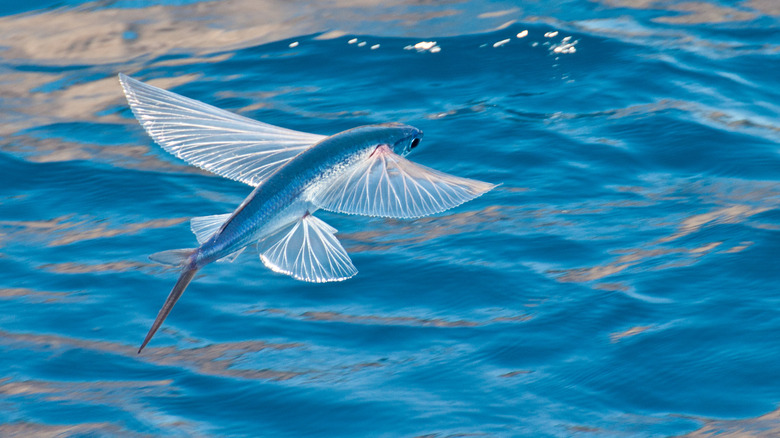Why The Garnai Fish Is The Swiss Army Knife Of The Ocean
When we think of sea creatures, one of the most defining attributes, of course, is swimming. Navigating the deep blue sea is a masterful and often necessary feat. Whales maneuver through the waves flexing their tails in a propellor-like fashion (via How Stuff Works). Sharks swim in a streamline, using continuous lateral undulations (per Harvard). According to Pet MD., aquatic turtles seem to paddle with their legs, using their webbed feet to remain afloat since they don't technically breathe underwater — at least not exactly in the same manner that fish do.
Perhaps the most captivating of all sea creatures, however, are those that don't really swim at all. Rather, they fly. You might have heard about the legendary Garnai fish, commonly referred to as the flying fish, and its mesmerizing affinity for flight. Here's why its flight pattern makes it the Swiss army knife of the ocean (via the National Wildlife Federation).
This fish has pectoral fins that act like blades to get it into the air
Flying fish might sound fictional, but according to the National Wildlife Federation, more than 40 different species of them are currently known to roam — or perhaps more accurately, hover — on Earth today.
When these fish are swimming through the sea, they keep their modified pectoral fins at their sides, gliding through the ocean waves with ease. When it comes time to soar into the air, they open those same fins like a Swiss army knife, cut through the rapid ocean waves, and shoot up into the sky at speeds exceeding 35 miles per hour.
With their knife-like fins spread wide as wings, National Geographic reports that the fish can achieve average flight heights of about four feet. In fact, there have been some extraordinary cases of Garnai fish soaring higher than four feet overhead. By sky and by sea, these fish are quite impressive, but their knifelike appearance is just the beginning.
A fork-like tail and a plant-like appearance keep it afloat
Surviving in the ocean takes some crafty maneuvering for smaller fish like the Garnai which maxes out at 18 inches in length, making it just slightly larger than a teacup, according to National Geographic. Not to worry though. The flying fish has quite the bag of tricks to ward off larger predators in hot pursuit. While its wings cut the waters like a Swiss army knife might, its tail is described as "unevenly forked," which helps it evade predators (via National Wildlife Federation).
Survival techniques are not limited to flying. The four-winged variation of this fish also has an affinity for gliding. It might not fly extremely high, but can glide with a pretty lengthy stride, exceeding 655 feet in some cases. It can also dip down to skim the water and come back up so several consecutive glides occur. Flying in this manner, the fish has been recorded to reach flight lengths of 1,312 feet, which is almost a quarter mile in distance.
Baby Garnai fish go the distance too. Born with whiskers positioned near their mouths, they hang out in the water camouflaged as plants until they're big enough to take on the skies.


